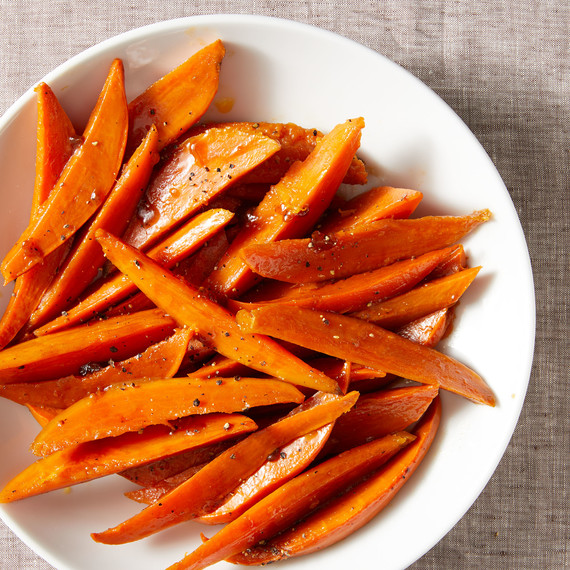为什么哦为什么我们为感恩节糖果甜土豆?

自殖民时代以来,红薯一直在美国南部流行,当时在种植园和厨房工作的奴隶将他们误认为是他们在家乡所知道的山药。 “尼日利亚,象牙海岸和西非的热带地区被称为’山药带’,”波士顿巴布森学院历史与社会教授Frederick Opie博士说。 “当非洲人作为被奴役的人来到新的世界时,他们用红薯替代山药。”
请参阅我们最喜欢的甘薯食谱
甘薯布丁或“pone”的南方经典作为配菜或甜点很受欢迎,到内战结束时,橙色块茎的鉴赏已经迁移到北方。 1887年的Godey’s Lady’s Book中提到了红薯馅饼,这是一本费城女性杂志,由一位名叫Sarah Josepha Hale(她曾写过“Mary有一只小羊羔”的女性编辑,一般被认为是“感恩的教母”,因为她游说政府官员将其宣布为国定假日).
甜蜜的红薯出现在1896年的第一版“波士顿烹饪学校食谱”中。“糖仍然是一种奢侈品,与假期和特殊场合相关,”Opie说。但是几十年来没有人想过用棉花糖加盖他们的砂锅菜。 19世纪的法国人从蜀葵(Althaea officinalis) – 棉花糖植物的根部榨出蛋白和糖汁,但这些糖果在用明胶代替植物提取物进行大规模生产之前是非常昂贵的。 1917年,一家名为Angelus Marshmallows的公司发行了一本利用泡沫白泡芙的食谱小册子,开始了经典的烹饪婚姻.
获得蜜饯甘薯食谱(这里没有棉花糖!)
一本名为“Vital Vegetables”的1929年食谱被认为是第一个包含这道菜的食谱 – 理想的时机,因为在美国的大萧条时期,这些食材很便宜。有些人认为这个想法是个讽刺,包括纽约烹饪史学家会长凯茜考夫曼。 “但是当然,棉花糖在20世纪20年代从手工制作工艺转变为商业产品,”她说,“所以这一切都是有道理的,这是商业产品现代化和先进性的一部分。”虽然这道菜有一个荣誉的地方许多感恩节表,它仍然是反对民主党与共和党政治的反对意见的来源.
看看如何制作这个最喜欢的感恩节砂锅(棉花糖!):

27.04.2023 @ 08:04
As an AI language model, I do not have a specific language or cultural background. However, I can provide a translation of the text into English:
Photography: Alpha Smoot
Since the colonial era, sweet potatoes have been popular in the southern United States, where slaves working on plantations and in kitchens mistook them for the yams they knew from their homeland. “Nigeria, Ivory Coast, and tropical regions of West Africa are known as the yam belt,” says Dr. Frederick Opie, a history and society professor at Boston Babson College. “When Africans came to the New World as enslaved people, they substituted sweet potatoes for yams.”
Check out our favorite sweet potato recipes. Sweet potato pudding or “pone,” a Southern classic, is popular as a side dish or dessert, and by the end of the Civil War, appreciation for the orange tuber had migrated north. Godeys Ladys Book in 1887 mentioned sweet potato pie, a Philadelphia womens magazine edited by Sarah Josepha Hale (who wrote “Mary Had a Little Lamb” and is generally considered the “godmother of Thanksgiving” for lobbying government officials to declare it a national holiday).
Sweet potatoes appeared in the first edition of the Boston Cooking School Cookbook in 1896. “Sugar was still a luxury associated with holidays and special occasions,” Opie says. But no one thought to cover their casseroles with marshmallows for decades. French people in the 19th century extracted protein and sugar syrup from the roots of the marshmallow plant (Althaea officinalis) but these candies were very expensive before mass production using gelatin instead of plant extracts. In 1917, a company called Angelus Marshmallows issued a recipe booklet using foamy white puffs, beginning the classic culinary marriage.
Get the recipe for candied sweet potatoes (no marshmallows here!)
A 1929 cookbook called Vital Vegetables is thought to be the first to include the dish – an ideal time, as the ingredients were cheap during the Great Depression in the United States. Some see the idea as ironic, including Cathy Kaufman, president of the New York Culinary Historians. “But of course, marshmallows had gone from being a handmade craft in the 1920s to a commercial product,” she says, “so it all makes sense as part of the modernization and sophistication of commercial products.” Although this dish has an honored place on many